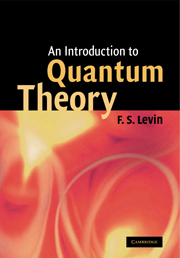Book contents
- Frontmatter
- Contents
- Preface
- PART I INTRODUCTORY
- PART II THE CENTRAL CONCEPTS
- Chapter 5 The Postulates of Quantum Mechanics
- Chapter 6 Applications of the Postulates: Bound States in One Dimension
- Chapter 7 Applications of the Postulates: Continuum States in One Dimension
- Chapter 8 Quantal/Classical Connections
- Chapter 9 Commuting Operators, Quantum Numbers, Symmetry Properties
- PART III SYSTEMS WITH FEW DEGREES OF FREEDOM
- PART IV COMPLEX SYSTEMS
- Appendix A Elements of Probability Theory
- Appendix B Fourier Series and Integrals
- Appendix C Solution of Legendre's Equation
- Appendix D Fundamental and Derived Quantities: Conversion Factors
- References
- Index
Chapter 5 - The Postulates of Quantum Mechanics
Published online by Cambridge University Press: 05 June 2012
- Frontmatter
- Contents
- Preface
- PART I INTRODUCTORY
- PART II THE CENTRAL CONCEPTS
- Chapter 5 The Postulates of Quantum Mechanics
- Chapter 6 Applications of the Postulates: Bound States in One Dimension
- Chapter 7 Applications of the Postulates: Continuum States in One Dimension
- Chapter 8 Quantal/Classical Connections
- Chapter 9 Commuting Operators, Quantum Numbers, Symmetry Properties
- PART III SYSTEMS WITH FEW DEGREES OF FREEDOM
- PART IV COMPLEX SYSTEMS
- Appendix A Elements of Probability Theory
- Appendix B Fourier Series and Integrals
- Appendix C Solution of Legendre's Equation
- Appendix D Fundamental and Derived Quantities: Conversion Factors
- References
- Index
Summary
In this chapter the basic concepts of quantum theory are formulated via a self-consistent set of six postulates. These six postulates deal with the following: operator images of physical observables; properties of state vectors and wave functions; the connection with experimental measurements; coordinate-space forms of those operators having classical analogs; the primary dynamical equation of quantum mechanics; and the completeness of the eigenvectors of observables. The postulates are the framework on which the edifice of quantum mechanics is constructed. A separate section is devoted to the statement of each postulate and to a few examples chosen to illustrate or apply it. A comprehensive set of applications is presented in Chapters 6 and 7, where various 1-D systems are used as the vehicles for illustrating the postulates. The basic theory of this chapter is extended and developed in Chapters 8 and 9. Since probability is a key interpretational concept, a brief introduction to this topic is given in an appendix.
We emphasize that our formulation of quantum theory (in this chapter and throughout this book) is restricted to the case of pure states. This is not a major restriction. It means that, when we consider ensembles of individual quantum systems (e.g., single particles, atoms, nuclei, etc.), all of the systems in the ensemble are assumed to be in the same quantum state, not necessarily an eigenstate of a quantal operator. Ensembles for which this assumption does not hold are described by a density operator or density matrix rather than by a pure state; treatments of such cases can be found in references cited later.
- Type
- Chapter
- Information
- An Introduction to Quantum Theory , pp. 129 - 173Publisher: Cambridge University PressPrint publication year: 2001



